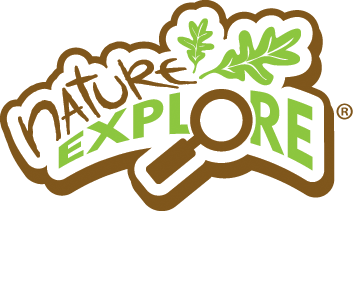Language and Literacy in the Outdoor Classroom
 This is the second in a series of blogs highlighting “Growing with Nature: Supporting Whole-Child Learning in Outdoor Classrooms.” Contributors include Dimensions Educational Research Foundation executive director Nancy Rosenow and members of the Nature Explore education team.
This is the second in a series of blogs highlighting “Growing with Nature: Supporting Whole-Child Learning in Outdoor Classrooms.” Contributors include Dimensions Educational Research Foundation executive director Nancy Rosenow and members of the Nature Explore education team.
“A child’s quest for knowledge about his world, which is energized by experiences in the outdoors, leads naturally to literacy. Kids have questions, and books have answers. A child who enjoys the tale of Peter Rabbit will be entranced by planting his own carrots—by living the story. It’s a beautiful, continuous loop of discovery that makes reading possible.”
–Vicky Stever, Director, Hurlburt Field Library
When children enjoy regular time with teachers and friends in nature-filled outdoor classrooms, language and literacy flourish in deeply meaningful ways. It has long been recognized that early language development provides the foundation for later learning in all curriculum areas. It is equally important to recognize that literacy development is about much more than learning a set of symbols (alphabet); it is a system for communicating and making meaning. Language development in nature begins in infancy and inspires ever-more complex communications as children grow.
Infants and Toddlers
Infants and toddlers who spend daily time in outdoor classrooms are naturally motivated to make connections with others. As they use all of their senses to interact with and explore an ever-changing array of natural materials, children will want to ask questions and practice new vocabulary. When caring adults support this natural curiosity and sense of wonder, relationships blossom.
Hannah (3 months) and I danced out the door to our outdoor classroom today. When we got inside the Nature Explore Classroom, I laid Hannah on her blanket near a tuft of tall grass. One particular seed head moved in the wind and curved into her visual field. Hannah looked at the grass intently for almost a minute. She then looked towards me. I said to her, “The grass moves in the wind.” Just then, a toddler played a few notes on the marimba. I asked her, “Did you hear the marimba?” Hannah responded, moving her body, starting from her toes and up to her head; she smiled and looked at me. She seemed to be very pleased. I said the word “marimba” again and she responded in the very same way.
–Heather Fox, Infant Teacher, Dimensions Early Education Programs
Preschool Children
As children grow, their explorations become more sophisticated. For example, preschoolers may be inspired to look very closely at beautiful shapes and textures found in leaves and flowers, in order to identify similarities and differences and distinguish patterns. Teachers who support this type of exploration realize children are practicing important skills, which are foundational for later development of reading and writing abilities. At this age, interesting real-life experiences in nature continue to inspire rich vocabulary development. In addition to the complexity of language that outdoor experiences encourage, many of the stories teachers have shared with us contain examples of imaginative phrasing and poetic words inspired by nature. Consider this example:
A three-year-old was swinging on a swing alongside me. She had closed her eyes, and when she opened them she said, “Wow… It’s bluer than I imagined it would be. When I close my eyes the sky is bluer that I imagined it would be when I open them again.”
–Kimberly Ryan, Preschool Teacher, Child Educational Center, La Canada, Californinia
Elementary School Children
Children in elementary grades can practice their growing literacy skills through “real work” in the outdoor classroom. They might use books as references to identify birds and insects, write signs for the garden, or create poetry inspired by nature’s beauty. Opportunities for projects and in-depth study encourage authentic conversation and vocabulary development. Nature filled classrooms provide a setting in which these projects can occur spontaneously.
For a number of months, students in my group eagerly made what we call “visual notes” to record their observations of the abundant plant and insect life in our Nature Explore Classroom garden. These notes were a combination of sketches and written words. Equipped with magnifying glasses, clipboards, paper and pencil, the students looked closely, taking their time moving through the garden, touching, smelling and sometimes even tasting the plant materials. Students observed carefully, drew sketches, then labeled their sketches of insects and flowers. Sometimes this led to research to determine what kids of flowers or insects children were finding.
–Holly Murdoch, School-age Teacher, Dimensions Summer Program
For numerous examples of language and literacy activities from Nature Explore classrooms around the country—as well as insights designed to inspire educators and families—“Growing with Nature” is available here

